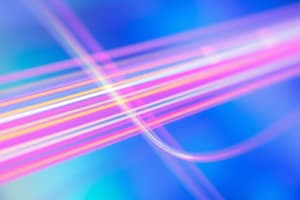Podcast
Questions and Answers
What is the focus of the lecture on Different types of Optical Sensors?
What is the focus of the lecture on Different types of Optical Sensors?
- Discussing the need for sensors
- Exploring the properties of light (correct)
- Demonstrating video game technology
- Analyzing the electric field amplitude
What physical parameters can be detected using the properties of light mentioned in the lecture?
What physical parameters can be detected using the properties of light mentioned in the lecture?
- Velocity and acceleration
- Temperature and pressure (correct)
- Sound and color
- Density and volume
How are Amplitude Modulators sensors referred to in common literature?
How are Amplitude Modulators sensors referred to in common literature?
- Television modulated sensors
- Intensity modulated sensors (correct)
- Amplitude modulators sensors
- Electric field amplitude sensors
What is the relationship between electric field amplitude and intensity modulated sensors?
What is the relationship between electric field amplitude and intensity modulated sensors?
In what context is a kid playing with a television mentioned in the lecture?
In what context is a kid playing with a television mentioned in the lecture?
What is the primary aim of the lecture on Optical Fiber Sensors?
What is the primary aim of the lecture on Optical Fiber Sensors?
What is the purpose of an optical sensor in the described application?
What is the purpose of an optical sensor in the described application?
What type of radiation is used by the infrared source in the application?
What type of radiation is used by the infrared source in the application?
How does the infrared sensor capture information about gestures?
How does the infrared sensor capture information about gestures?
What is the main purpose of using CCD array in this application?
What is the main purpose of using CCD array in this application?
What is the significance of scattering only a few dots from an object?
What is the significance of scattering only a few dots from an object?
What do fine features of the pattern of dots allow for in this application?
What do fine features of the pattern of dots allow for in this application?
How is near infrared radiation different from visible radiation?
How is near infrared radiation different from visible radiation?
What does gesture recognition involve in this context?
What does gesture recognition involve in this context?
Flashcards are hidden until you start studying
Study Notes
Optical Sensors Lecture
- The lecture focuses on different types of optical sensors and their applications.
Physical Parameters and Light Properties
- Physical parameters such as temperature, pressure, and vibration can be detected using the properties of light, including amplitude, phase, and polarization.
Amplitude Modulators
- Amplitude Modulators sensors are commonly referred to as Intensity Modulated Sensors.
Electric Field Amplitude and Intensity Modulated Sensors
- Electric field amplitude is directly related to intensity modulated sensors, as changes in amplitude affect the intensity of the light.
Television Analogy
- The lecture uses the example of a kid playing with a television to illustrate how an optical sensor can capture information about gestures.
Optical Fiber Sensors
- The primary aim of the lecture on Optical Fiber Sensors is to discuss their applications and types.
Sensor Purpose and Application
- The purpose of an optical sensor in the described application is to capture information about gestures.
- The optical sensor is used in an application involving gesture recognition.
Infrared Radiation and Sensor
- The infrared source in the application uses near-infrared radiation, which is different from visible radiation.
- The infrared sensor captures information about gestures by detecting changes in the scattered near-infrared radiation.
CCD Array and Scattering
- The main purpose of using a CCD array is to capture the scattered near-infrared radiation and create an image of the object.
- Scattering only a few dots from an object allows for the creation of a pattern of dots.
- The fine features of the pattern of dots allow for the recognition of gestures.
Gesture Recognition
- Gesture recognition involves the detection and interpretation of gestures using the captured information about the scattered near-infrared radiation.
Studying That Suits You
Use AI to generate personalized quizzes and flashcards to suit your learning preferences.




